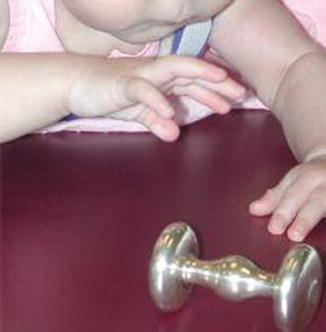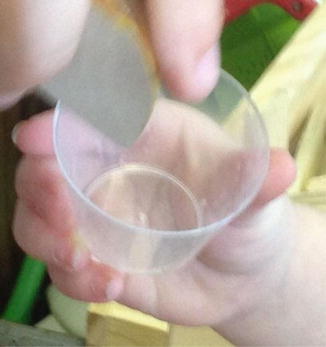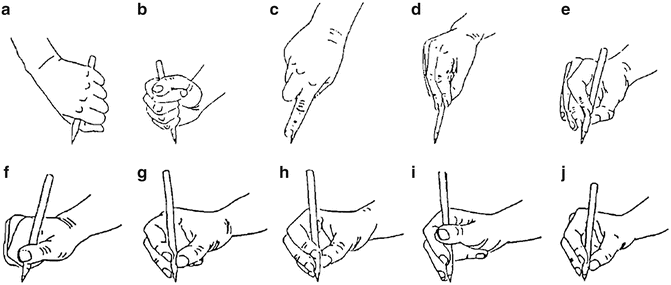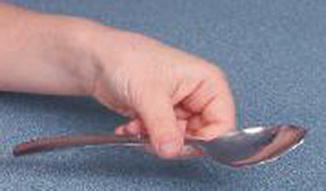Description
Example actions
Visual regard
Attention on an object and associated visual perception prior to an action
Determining the location and orientation of a pencil
Reach and grip Formation
Arm transport to object location and hand pre-shaping to match object characteristics (i.e., size, shape)
Reaching for a pencil and opening fingers slightly wider than the diameter
Grasp
Finger and thumb closure with or without sustained pressure to stabilize an object
Securing and holding the pencil
Manipulation
Movement of an object in one hand
Rotating or adjusting the fingers toward the pencil tip in one hand
Release
Manner in which an object leaves the hand or taking pressure off of an object
Letting go of the pencil on the table
Vision
Vision guides prehensile acts to enhance accuracy and control. Visual perception allows us to recognize, recall, discriminate, and understand what we see (Goodale and Milner 1992). Depth perception , figure ground, and visuo-construction are select perceptual constructs used in everyday tasks. Depth perception allows us to estimate distance and size of objects in the environment. Figure ground helps us to selectively screen out background stimuli to focus on foreground details. Visuo-construction is a spatial planning process involved in building two- and three-dimensional objects such as a model airplane. Experience contributes to visual memory to further guide prehension.
We use visual–motor control for precise movement guidance. Peripheral vision provides cues about object distance and direction during reaching (Abahnini and Proteau 1997), whereas central vision allows fixation on critical landmarks for fine-motor control during manipulative tasks. When vision is compromised, we rely on somatosensory cues or visual memory to guide prehension.
Reaching
Features
Reaching is the extent, orientation, and speed of the hand path as it moves to a new position (Abend et al. 1982). With reach-to-grasp tasks, the shoulder places the hand over a wide area in space and the elbow places it close or far from the body. The forearm and wrist accurately position the hand before grasping or weight bearing, and during grip formation, the fingers and thumb accommodate for object size and shape.
Reaching in late adolescence is characterized by smooth velocity profiles and relatively continuous, straight hand paths to the target (Jeannerod 1984). Grip formation or pre-shaping of the hand to object shape and size gradually unfolds with reaching and can be divided into finger opening and closure. The timing and size of peak finger opening gradually scales and by adolescence occurs within 70–75 % of total movement time of a reach (Jakobson and Goodale 1991; Jeannerod 1984).
Development
Pre–reaching is described as a flapping, inaccurate movement with frequent accelerations and decelerations. Anticipatory, visually guided reaching emerges between 3 and 4 months of age (Thelen et al. 1996). von Hofsten and Lindhagen (1979) showed that 4-month-old infants could predict or anticipate the future position of a slowing moving ball and catch it by directing the hand toward the upcoming point of contact. Unimanual and bimanual reaching behavior fluctuates in the first year and is influenced by postural control (Corbetta and Thelen 1996; Corbetta and Bojczyk 2002; Rochat 1992). By 2 years of age, toddlers display more adultlike reaching patterns (Konczak and Dichgans 1997) with less variability in repeated performance.
Grip formation has been documented in infants as young as 18 weeks (von Hofsten and Fazel-Zandy 1984), yet scaling to object size gradually improves throughout childhood. Before object contact, infants and young children open their hand wider than necessary, which allows a higher safety margin of error to prevent missing targets (Fig. 1). Finger opening is modified to target size in 9–13-month-old infants, and by 13 months, infants initiate finger closure prior to object contact. Six-year-olds continue to display exaggerated finger opening during reaching, whereas 12-year-olds scale finger posture more closely to object size (Kuhtz-Buschbeck et al. 1998). Grip formation is not adultlike until late childhood (Kuhtz-Buschbeck et al. 1998).


Fig. 1
Pre-shaping of the hand in a young infant elicited in preparation of toy contact
Grasp Patterns
Features
The characteristics and purpose of an object determine the grasp pattern used to secure it (Newell et al. 1989). Power grips are thumb and finger actions that act against the palm to apply a force to an object (Napier 1956) and primarily include cylindrical, spherical, and hook grips. For precision grip or pinch tasks, forces are directed between the fingers and thumb and primarily include pad-to-pad, tip-to-tip, and lateral or key pinch. Isometric muscle contractions are used to sustain power and precision grips. Table 2 lists the muscles and joints associated with common prehension patterns.
Table 2
Classic prehension patterns
Patterns | Joint motion | Muscles used | Function |
|---|---|---|---|
Cylindrical grasp | Thumb opposition, finger adduction, and flexion | FPL, thenar group, AdP, 4th lumbrical, select interossei, FDP (FDS more power) | Grasp and hold of a cylindrically shaped object such as a can of soda |
Spherical grasp | Thumb opposition, finger flexion, and abduction | FPL, thenar group, AdP, FDP (FDS more power), AbDM, 4th lumbrical, all interossei (except 2nd) | Grasp and hold of a round object such as a softball |
Hook grasp | MCPs neutral, flexion PIPs/DIPs, and thumb extension | FDS and FDP, EPL and EPB, EDC, 4th lumbrical and 4th dorsal interossei | Grasp and hold of a small luggage handle |
Pad-to-pad pinch | Thumb opposition with slight thumb and index flexion, MCP/PIP flexion, and slight index DIP flexion | Thenar group, FPL, FDS of involved fingers (FDP if DIP flexion present), 1st DI and 1st lumbrical | Grasp and hold over the head and tail aspects of a coin |
Tip-to-tip pinch | Features of pad-to-pad pinch, with greater thumb/finger flexion, with index DIP flexion | Features of pad to pad, with greater FPL and FDP force due to DIP flexion, index interossei | Picking up a needle |
Lateral (key) pinch | Thumb adduction with IP flexion, index finger flexion, and abduction | FPL, FPB, AdP; FDS and FDP all fingers; less interossei and lumbricals except first DI | Turning a key in a lock |
We typically grade the fingertip forces used to secure and lift objects based on memories of object weight, texture, and other features. Fingertip force control is triggered by discrete mechanical events that relay information from somatosensory receptors relevant to object contact and slip (Johansson and Cole 1992). Feedforward or anticipatory control is used to grade the grip (squeeze) and load (vertical) forces in advance of contact, whereas feedback control is used to make adjustments after contact. When turning a key in a tough lock, a strong steady grip force is used, but a light load force is sufficient to lift an empty soda can. Friction at the interface between the finger and object helps to maintain a secure grip on objects (Aoki et al. 2006). To prevent drops, feedback obtained from tactile receptors induces an increase in grip force. Without sufficient anticipatory control or tactile feedback, objects may slip from grasp or be squeezed too tight.
Development
In the first few months of life, tactile and proprioceptive reflexes control finger opening and closure (Twitchell 1970). Gradually hand reflexes are integrated and evolve into voluntary prehension patterns. From birth to 5 months, an array of patterns unfold (Wallace and Whishaw 2003). Initial grasp patterns involve the fingers only, with the thumb function progressively included from 3 to 12 months. With postnatal neural development, independent finger movements emerge. Index isolation is often seen about 10 months of age, and the index evolves into a dominant pointer by 1 year of age. By 11 months, infants display pad-to-pad opposition of the thumb to index to grasp small objects. Further development and experience helps to expand the repertoire of functional grasp patterns which become more adultlike by the end of the first year.
The popular view of prehension development is shown in Table 3. However, there may be subtle variations to this viewpoint. Halverson (1931, 1932) indicated that an ulnar grasp, elicited by tactile cues to the ulnar hand, preceded a radial grasp. However, Forssberg et al. (Lantz et al. 1996) found that after palm contact, young infants may display a palmar grasp for a dumbbell-shaped object (see Fig. 1). This suggests that object characteristics may influence the pattern displayed more than previously assumed (HohIstein 1982; Newell et al. 1989).
Table 3
Prehension development from birth to 1 year
Description | Age | Illustration | Stimulation |
|---|---|---|---|
Recognizes hands | 8 weeks (2 months) | Hand enters visual field via ATNR | |
Reflexive ulnar group | 12 weeks (3 months) | Object placement onto ulnar side of hand elicits grasp | |
Retains objects placed in hand: fingering on chest in midline, finger mouthing, and object swiping | 16 weeks (4 months) | Object placement in hand will foster grasp and hold; hanging toys in visual field will encourage swiping | |
Primitive squeeze grasp (wrist flexed), raking | 20 week (5 months) | Introduction of varied toys will foster raking and voluntary grasp | |
Palmar grasp (no thumb wrist moves to neutral) | 24 weeks (6 months) | Placing toys in different positions will encourage eyes and hands to search prior to reach and grasp | |
Radial palmar grasp (thumb adduction begins) | 28 weeks (7 months) | Ideal toys are those that can be picked up and transferred easily from one hand to the other | |
Scissors grasp (thumb adduction stronger) | 32 weeks (8 months) | Introduction of toys with a thin circumference will strengthen thumb adductor | |
Radial-digital grasp (beginning opposition) | 36 weeks (9 months) | Toy clay or finger food that is pliable will foster opposition | |
Inferior pincer grasp (volar hold versus pad to pad, hand supported prior to grasping) and isolated index pointing | 36–52 weeks (9–12 months) | Small objects varied in shape will promote exploration via poking, feeling, and manipulation | |
Pincer grasp-pad to pad (some support before grasping) | 38–52 weeks (10–12 months) | Tiny objects, such as raisins, to pick up and drop will encourage development | |
Superior pincer grasp-tip to tip (hand unsupported prior to grasping) | 52–56 weeks (1 year) | Thin yet safe objects the size of a pin will encourage development | |
Three-jaw chuck (wrist extended and ulnarly deviated), maturing release | 52–56 weeks (1 year) | Toys requiring a strong radial hold like blocks with containers allowing for repeated actions will foster strong grasp & release |
Anticipatory fingertip force control during grasp and manipulation develops gradually over the first 2 years (Forssberg et al. 1995; Pare and Dugas 1999). Initially, infants and toddlers increase grip and load forces sequentially, using a feedback strategy (Forssberg et al. 1995). In the second year, grip and load forces begin to be generated in parallel, displaying a transition to anticipatory control as the child begins to use cups, utensils, writing implements, and self-care items (Fig. 2). Until sufficient fingertip force control develops, children may crush fragile objects such as paper cups or potato chips or lift light objects too quickly. With the improvement in distal control, crayon and pencil grips are modified. A developmental scale of pencil grip is shown in Fig. 3.



Fig. 2
Grading of opposing fingertip forces used during grasp and lift of objects such as a plastic cup

Fig. 3
Developmental scale of pencil grip: (a) radial cross-palmar grasp, (b) palmar supinate, (c) digital pronate, (d) brush grasp, (e) grasp with extended fingers, (f) cross-thumb grasp, (g) static tripod grasp, (h) four-finger grasp, (i) lateral tripod grasp, and (j) dynamic tripod grasp (Redrawn from Schneck and Henderson 1990)
Although some 6- and 8-year-old children demonstrate adult-like fingertip force coordination during object manipulation, some do not attain this ability until 11 years of age or later (Forssberg et al. 1995).
Manipulation
Features
Manipulation or haptic exploration requires alterations in object position in space and accurate control of thumb and finger position (Landsmeer 1962). Manipulation of an object within one hand is entitled in–hand manipulation and can be divided into translation, shift, and rotation (Exner 1990). Translation involves object movement from palm to fingers or fingers to palm as when one moves a coin before placing it in a slot. Shift is the movement of an object along the finger pads or fingers as when moving a pencil toward the fingertips. Rotation incorporates motion of an object around its axis within the fingers as when turning a spoon in the hand or a pencil to erase (Fig. 4). In-hand manipulation skills can involve stabilization of an object or part of an object within the hand, while another object or part is concurrently manipulated within the same hand (Exner 1990).




